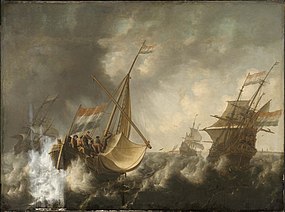| This article needs additional citations for verification. Please help improve this article by adding citations to reliable sources. Unsourced material may be challenged and removed. Find sources: "Jacob Jacobs" artist – news · newspapers · books · scholar · JSTOR (January 2018) (Learn how and when to remove this message) |
| Jacob Jacobs | |
|---|---|
 Jacob Jacobs, posthumous portrait Jacob Jacobs, posthumous portraitby Eugène Joors, 1884 | |
| Born | 19 May 1812 Antwerp, First French Empire |
| Died | 9 December 1879 Antwerp, Belgium |
| Education | Royal Academy of Fine Arts (Antwerp) |
| Known for | Painter |
| Notable work | Landscapes, Oriental themes |
| Movement | Orientalist |
Jacobus Albertus Michael Jacobs, known as Jacob Jacobs (19 May 1812, Antwerp – 9 December 1879, Antwerp) was a Belgian landscape and seascape painter in the Romantic style, with a preference for northern and "oriental" scenes.
Life

On his mother's side of the family, he was related to Beethoven. Although his parents originally intended for him to become a printer, they eventually gave in to his wishes and he was enrolled at the Royal Academy of Fine Arts (Antwerp), where he studied with Gustaf Wappers and Ferdinand de Braekeleer the Elder. He continued his studies in Leuven where he was influenced by the works of Ludolf Bakhuizen and Adriaen van de Velde and chose to focus on maritime scenes. His first exhibitions came in 1833. He took a trip to the North Sea in 1834, and a final study trip through the Netherlands in 1837 produced much material.
Still, he was dissatisfied with what he had seen so, in 1838, he left on a long sea voyage that would take him to Gibraltar, the North African coast, Egypt, the Dardanelles, Istanbul (where he remained for several months), Asiatic Turkey and Rhodes. While in Ankara, he met and befriended his fellow Belgian painter, Florent Mols, and they continued travelling together; sailing down the Nile as far as Nubia. During these travels, he compiled two huge albums of drawings and notes that he would use for inspiration the rest of his life. In 1847, still restless, he toured Northern Germany and, in 1850, Scandinavia.
In 1843, he succeeded Jean-Baptiste De Jonghe as head of the landscape painting classes at the Antwerp Academy, where some of his best-known students were Emile Claus, Frans Hens and Adriaan Jozef Heymans. Two years later, he was one of the many Belgian artists who provided illustrations for the Geschiedenis van België (History of Belgium) by Hendrik Conscience.
See also

References
- ^ Biography in De levens en werken van Hollandse en Vlaamsche kunstschilders, Vol.1 by Johannes Immerzeel@ Google Books
Further reading
- Willem G. Flippo, Lexicon of the Belgian Romantic Painters, International Art Press, Antwerpen, 1981.
- Philippe Cruysmans, et al., Peinture orientaliste, Editions Leconti, Brussels, 1982.
- Norbert Hostyn et al., Marines des peintres belges nés entre 1750 et 1875, Brussels, 1984.
- Norbert Hostyn, "Jacob Jacobs", in Nationaal Biografisch Woordenboek, 11, Brussels, 1985.
- Paul Piron, De Belgische beeldende kunstenaars uit de 19de en 20ste eeuw, Art in Belgium, Brussels, 1999 (2 vols.) ISBN 90-7667-601-1
- Paul Piron, Dictionnaire des artistes plasticiens de Belgique des XIXe et XXe siècles, Lasne, 2003.
- Eugène Warmenbol, L'orientalisme en Belgique: L'Egypte vue par Florent Mols et Jacob Jacobs (1838-1839), Editions Racine, Brussels, 2012 ISBN 978-2-87386-809-3
External links
[REDACTED] Media related to Jacob Jacobs at Wikimedia Commons
Categories: